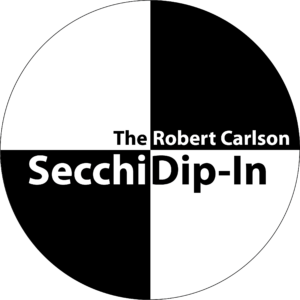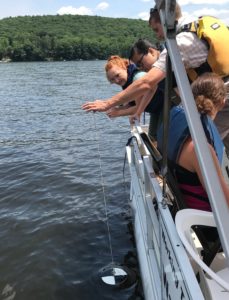2020 Secchi Dip-In Update
 With support from a USEPA Exchange Network grant, NALMS partnered with the Oklahoma Water Resources Board, Gold Systems, and Cary Institute of Ecosystem Studies to upgrade the Secchi Dip-In database using the Ambient Water Quality Monitoring System (AWQMS) and Global Lake Ecological Observatory Network (GLEON) Lake Observer mobile app. These existing data entry and database management tools have been customized for Dip-In use and to make data publicly available through the AWQMS database, USEPA’s Water Quality Exchange (WQX), and the Water Quality Portal (WQP), a water quality data clearinghouse.
With support from a USEPA Exchange Network grant, NALMS partnered with the Oklahoma Water Resources Board, Gold Systems, and Cary Institute of Ecosystem Studies to upgrade the Secchi Dip-In database using the Ambient Water Quality Monitoring System (AWQMS) and Global Lake Ecological Observatory Network (GLEON) Lake Observer mobile app. These existing data entry and database management tools have been customized for Dip-In use and to make data publicly available through the AWQMS database, USEPA’s Water Quality Exchange (WQX), and the Water Quality Portal (WQP), a water quality data clearinghouse.

A Secchi disk reading at Lake Wallenpaupack, Pennsylvania as part of the Poconos Lake Ecological Observatory Network (PLEON).
NALMS launched the new AWQMS Dip-In database this year with a web app for data entry by citizen scientists, a spreadsheet template for bulk data uploads by volunteer monitoring program coordinators, a public portal for data visualization and download, capabilities for migrating data from the Lake Observer app, and a direct connection to upload collected water quality data to the federal government’s WQX/WQP databases. We have already received over 300 Secchi depth measurements and a total of nearly 1,000 water quality and weather observations. Volunteers have submitted data from 22 states and two Canadian provinces via the AWQMS database and 11 states via the Lake Observer app. We also saw a steady stream of data being submitted via the Lake Observer app from Lake Wallenpaupack in Pennsylvania as part of the Poconos Lake Ecological Observatory Network (PLEON) organized by Beth Norman, research director at Lacawac Sanctuary, from Arkansas by a new group of volunteers organized by past president and longtime NALMS member Reed Green and the Central Arkansas Master Naturalists, and from Hillsborough County, Florida by veteran mobile app beta tester Sheryl Bowman.
NALMS intern Maggie Reilly has been busy working with the Dip-In team to help prepare the database, assist users with data entry, and conduct GIS analysis to help merge in the previous monitoring locations. By the end of this month, we expect to have a drop-down list of water quality monitoring programs available for users to select when entering data.
The Secchi Dip-In is part of Lakes Appreciation Month in July each year, but we accept data year-round. With the recent database upgrade, we will be updating guidelines to encourage volunteers to submit as much data as you are willing to share. If you have a backlog of data stored in a spreadsheet that has not been submitted as part of the Dip-In or via a state agency or tribal organization to WQX/WQP, including data from previous years while we were making the transition to the new database, we invite you to register for an account or contact us for assistance with submitting data via AWQMS or Lake Observer app bulk upload tools.
For those who had registered for accounts and entered data using the previous NALMS database, we appreciate your patience and cooperation while we transition to the new database, which also requires that you create a new account. All of the historical data is in the AWQMS database, so rest assured that no data has been lost. The Dip-In database archive has also been shared with the federal WQP data clearinghouse where it is being used by monitoring programs and researchers to advance our understanding of lakes in a time of global change.
Visit the Dip-In website to learn more about this volunteer water quality monitoring effort (https://www.nalms.org/secchidipin/) or contact us at secchidipin@nalms.org.

